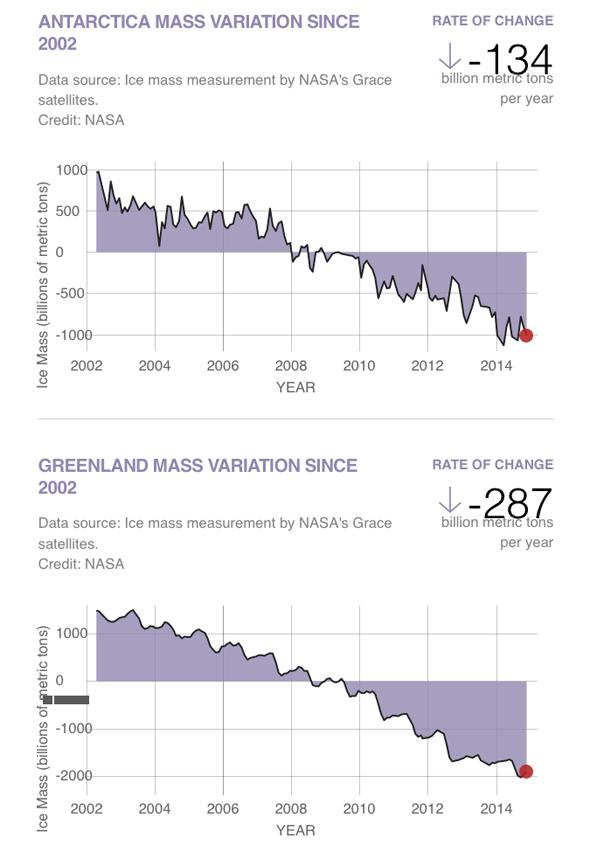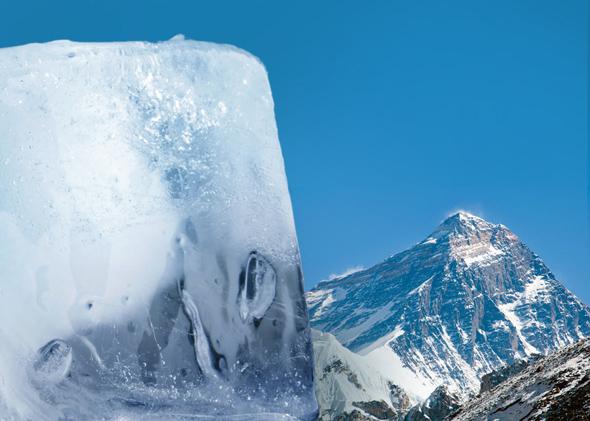I’ve been writing about what global warming means to our planet and to us for a long time now. A critical concern for this is the loss of land ice in Antarctica and Greenland, for many reasons. One is that it’s a bellwether for our poles, a preview of what it means as we turn up the global thermostat. Another is that it contributes to sea level rise, which has been moving upward for quite some time now.
But land ice loss is perhaps most important as a political trigger; the sheer amount of land ice being lost every year is immediate, here, now. And the numbers are staggering: Using data from the GRACE satellites launched in 2002, scientists measured that the Antarctic ice sheet is losing 134 billion metric tons per year, and Greenland is losing 287 billion tons per year.

Graphs by NASA
I’m an astronomer. I deal with numbers this large all the time. But internalizing them is another issue altogether; after a while they just become, well, numbers.
Perhaps a change in perspective is called for. Those rates quoted are horrific, but what do they mean for the total ice lost from those two regions?
On Wednesday, NASA posted the graphs above on its climate change website, and that hammered home just what 420 billion tons of ice melting annually means when looking back into the recent past.
From 2002 to mid-November 2014—less than 13 years—the combined land ice loss from Antarctica and Greenland is more than 5 trillion tons.
Five. Trillion. Tons.
That’s beyond staggering; that’s almost incomprehensible. It’s a volume of about 5,700 cubic kilometers, a cube of ice nearly 18 kilometers—more than 11 miles—on a side. Place that cube on the ground, and the top of it would be above 90 percent of the Earth’s atmosphere, reaching twice the height of Mount Everest.

Photo illustration by Lisa Larson-Walker. Photos by Daniel Prudek/Thinkstock and StudioZ/Shutterstock.
Five trillion tons. Remember that the next time some climate change denier starts spouting the usual nonsense about sea ice increasing. That claim is very close to a bald-faced lie. First, arctic sea ice is declining rapidly. Second, arctic sea ice loss is so huge that it easily overwhelms any temporary gains in Antarctic sea ice. And third, sea ice is very different than land ice. Land ice loss isn’t getting replaced anywhere near the rate it’s being lost. Once it slides into the sea, it’s gone.
Except it isn’t really. It’s gone as ice. It’s still there as fresh water, making sea levels rise and potentially altering the currents of warm and cold water that further regulate our climate.
Whenever I make a post like this, I get emails, tweets, and comments from people who deny global warming is happening, and they point to fatally flawed “evidence”—cherry-picking data (like looking at small regions instead of global data), ignoring trends to look for small spikes in time, distracting people by using misleading examples of cooling or ice growth. It’s the same tired garbage all the time.
The reality is we’re warming up. The reality is we’re losing ice at both poles at tremendous rates. The reality is our climate is changing, our weather is changing, our lives are changing.
We need to recognize that, and we need our politicians to recognize that. The deniers rely on bad science and pathological interpretations. Despite recent baloney about it (is Rick Santorum ever right about anything?), in fact the overwhelming majority of climate scientists agree: Global warming is real and it’s our fault.
We need to elect politicians who understand that, and are willing to take action about it. Or else in the not too distant future, 5 trillions tons is going to seem like a drop in the bucket.
Correction, Sept. 3, 2015 at 16:00 UTC: My apologies; I had written 1992 instead of 2002 in a few places in this article—that was a holdover from an earlier draft covering a different aspect of global warming and I somehow missed it when I was editing the final version. Sorry for the confusion.